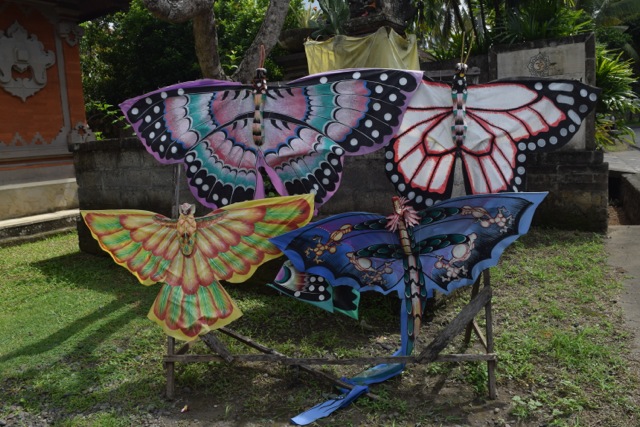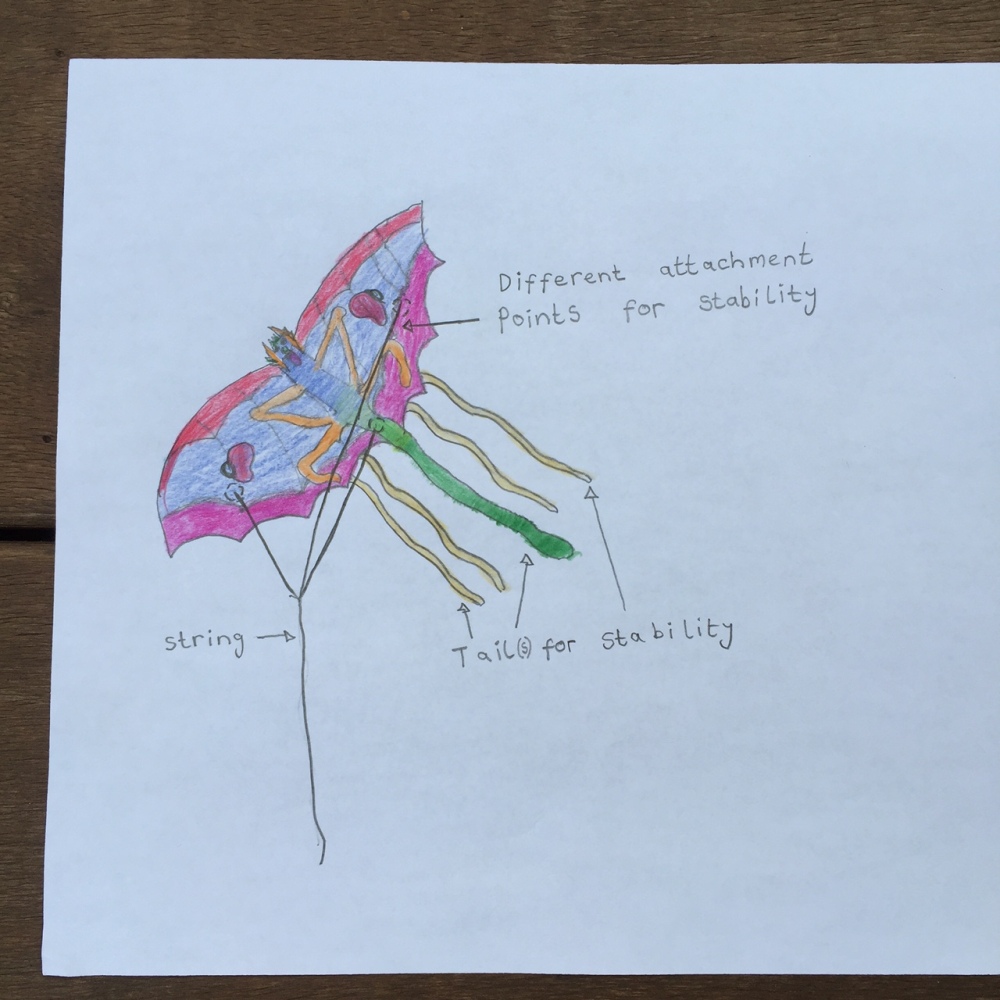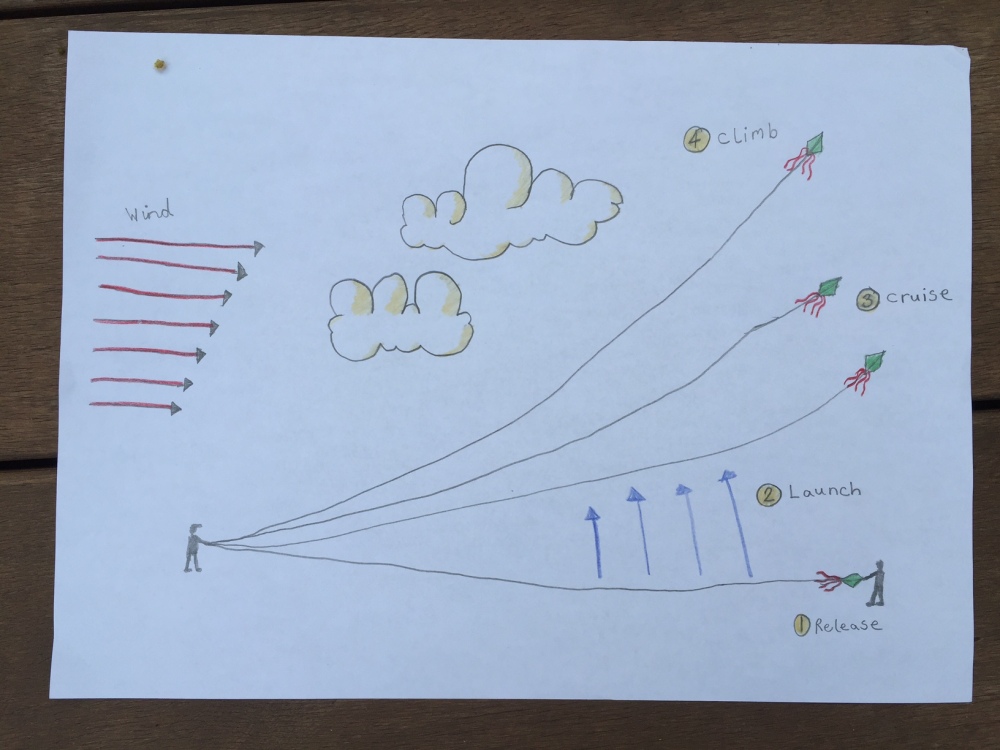A few days ago, I noticed that there were lots of beautifully made and decorated kites in the sky.

I thought that maybe there was a special festival of a traditional celebration. When we arrived back at our villa, I decided to do some further research about the kites I kept on seeing everywhere. I found out that from June to September is the windy season and that kites are not just for young children but they are also flown by grown up men. Children usually build kites about three metres in length and 1 metre wide, whereas the grown ups can build kites up to 5 metres wide and maybe even 40 metres long!
Traditional kites are mainly animal shapes such as butterflies, tigers and fish. It said in the book that these days, kites are shaped like cars and motorbikes.


I didn’t see one modern kite in the sky, only traditional ones which have extremely bright colours and usually have a small wooden animal face or mask at the top.


I also found out that every year in Sanur (in the southeast of Bali) that there is a kite competition for men. The men usually carry ginormous kites either by foot or they delicately pack them into big trucks. If by foot, it sometimes takes about a dozen men to carry one single kite. Traditionally, village kites compete against each other.The kites are so big that the men can’t just carry them on the side of the road, so the kites can take up the whole width of the road. This causes a lot of traffic on the roads.
In the 1930’s, the village kite of Yang Batu Kangin that is in Denpasar won 2nd prize. All the villagers were very happy. It is said that the kite had an 80 metre long tail, even though I don’t believe it as it sounds nearly impossible to build. The kite had a cultural mask at the front that was carved especially using the wood of the sacred pule tree.
Strangely, the winners abandoned their kite until one day during a trance, a women talked to a spirit that was said to be Ratu Ayu (Saint Beautiful). The spirit told the women that she was living in the abandoned kite. Ratu Ayu also said that she would protect everyone from the village of Yang Batu Kangin. The surprised women thanked the kind spirit and ran back to the village of Yang Batu Kangin and told everybody what she had saw. The women told all the villagers to build Ratu Ayu a shrine to show the spirit their thanks. A few days later, the shrine was built in a temple in Denpasar. It the villagers made offering for Ratu Ayu on each auspicious day. Not long afterwards, their was an epidemic in the whole of Denpasar and only the villagers of Yang Batu Kangin were spared. Since then, the kite was put in the same temple that held the shrine of Ratu Ayu and was never forgotten again.
What really fascinates me about kites is how they manage to fly with the wind and stay in the air for such a long time. Now I am going to tell you about how they fly:
How the kites get into the air
You need two people to start the kite flying; one person holds the end of the string and the other holds the kite at the opposite end. As soon as a gust of wind blows, the person holding the kite lets go. To get it as high as you can when launching it, the person who lets go could try to give it a little push up into the air. This is what I think is the easiest way to start the flight. Another way of doing it if you gong have someone to help you is to lay the kite on the floor and hold the string. When a gust of wind approaches, run as fast as you can to get the kite in the air.




The principles of flight
Airplanes use the same technique as kites, but some parts are a bit more complicated. Let me tell you more about the principles of flight:
When airplanes are in the air, they have two negative points that stop them from flying so well and two positive points. Here is a diagram I did of an airplane during flight:

The four points are,
1.Thrust (forward)
2.Lift (upwards)
3.Weight (downwards)
4.Drag (backwards)
The thrust is caused by the engines of the plane to push it forwards. The drag works the opposite way to the thrust and pulls the airplane backwards. There is only one way to stop the thrust which is to make the airplane as thin as they can. This helps the wind go on top or underneath the plane instead of hitting in straight in the middle. The way air moves around objects is called aerodynamics. If the plane was extremely thick like a 3-D block, the wind would hit it entirely and push it backwards. It also works the same way with cars; the thinner, the faster. Here areo three pictures about aerodynamics and two of them are different cars I drew to help you understand a bit better about how drag and thrust and drag works. (The thin one is an Italian Ferrari and the other is also an Italian cinquecento).



Finally I’m going to tell you about lift and weight. The wind catches the underneath of the wings and push the plane upwards. This is how kites and airplanes get off the ground. The weight is the opposite force of the lift. Because the lift and weight work against each other, once the plane or kite is in the air it will always stay at one level. This also happens with the speed of the plane (the thrust and drag work agains each other so the plane will always stay at one speed.)
I very much enjoyed photographing all the different kites I saw these past few days and writing about the principles of flight. When I wrote this article, it very much reminded me of when I went to see lots of Leonardo da Vinci’s flying inventions in the Leonardo museum in Rome. Unfortunately, we couldn’t make it to Denpasar to see the famous kite as we were staying in Ubud which is a bit further north, but I would definitely like to go and see it if I go to Bali again when I am older.
Apollinaire 🌬🐉 🛫


Dear Apollinaire, what interesting traditions you have in Bali. Could you write something concerning traditional dolls & toys? I’m a designer and make toys myself. I would be glad to learn and see at least some photos of them.
Keep up your job! Good luck!
Maria
LikeLike
Dear Maria, thank you so much for reading and commenting on our blog as it supports me a lot when I write different articles. I will try my best to fit in a small entry about traditional games, dolls and toys as soon as I can. Thank you again, from Apollinaire
LikeLiked by 1 person
Dear Apollinaire,
You’re always welcome! I’ll be looking forward to read this information. Go on with blogging! Good luck and inspiration!
LikeLike
Dear Maria,
Thank you for your encouraging thoughts. I will try my best to keep the posts running and up to date but sometimes we are travelling a lot to small islands and we don’t have much time to homeschool. I am really pleased you are following the blog and I am hoping to keep in touch.
From Apollinaire 😊
LikeLiked by 1 person
Dear Apollinaire,
here is a post I wrote sever years ago.
It’s dedicated to toys. I wrote it for adults for us not to forget that toys have an important influence on us, no matter how old we are:
https://eternamenta.wordpress.com/articles-in-english/toys-can-speak-do-you-know-to-listen-to-them/
LikeLike
Dear Maria,
Thank you so much for this amazing and very interesting link. I was very intrigued and I always wondered if toys do actually communicate and speak to each other while we’re away and not looking. I left a comment on your blog and I am hoping to carry on following you and staying in touch.
From Apollinaire 😊
LikeLiked by 1 person
Hi Apollinaire 😘😘 I love to fly kites & appreciated learning the science behind the art of kite flight. There is a book you might enjoy called The Kite Runner… Kite flying is a secondary theme that interweaves the main plot line. Well done Apollonaire thank you! 👍🏻👍🏻😘
LikeLike
Dear Joni, thank you for your encouragement and lovely comment. I will ask my Dad just after writing this if I could get the book in a local english bookshop. It already sounds very intriguing and I can’t wait to read it. Thank you for mentioning and please keep in touch! Love from Apollinaire 💚😊
LikeLike
I’ve never flown a kite, but hope to do so one day!
I will try to remember all of the above next time I sit in an aeroplane!
LikeLike
Thank you Narayan! When I was writing the article about Kites and the Principal of Flight I got quite confused myself so I am really happy you understood. from Apollinaire 😛
LikeLike